Alteration of TLR3 pathways by glucocorticoids may be responsible for immunosusceptibility of human corneal epithelial cells to viral infections
- PMID: 19452017
- PMCID: PMC2683030
Alteration of TLR3 pathways by glucocorticoids may be responsible for immunosusceptibility of human corneal epithelial cells to viral infections
Abstract
Purpose: The toll-like receptor 3 (TLR3) recognizes viral double-stranded RNA and its synthetic analog polyriboinosinic-polyribocytidylic acid (poly(I:C)), and the activation of TLR3 is known to induce the production of type I interferon (IFN) and inflammatory cytokines/chemokines. The purpose of this study was to determine the role played by innate responses to a herpes simplex virus 1 (HSV-1) infection of the corneal epithelial cells. In addition, we determined the effects of immunosuppressive drugs on the innate responses.
Methods: Cultured human corneal epithelial cells (HCECs) were exposed to poly(I:C), and the expressions of the mRNAs of the cytokines/chemokines macrophage-inflammatory protein 1 alpha (MIP1-alpha), macrophage-inflammatory protein 1 beta (MIP1-beta), interleukin-6 (IL-6), interleukin-8 (IL-8), regulated on activation, normal T cell expressed and secreted (RANTES), Interferon-beta (IFN-beta), and TLR3 were determined using real-time reverse transcription-polymerase chain reaction (RT-PCR). The effects of dexamethasone (DEX, 10(-6) or 10(-5) M) and cyclosporine A (CsA, 10(-6) or 10(-5) M) on the expression of these cytokines and TLR3 were also determined using real-time RT-PCR. Levels of MIP1-alpha, MIP1-beta, IL-6, IL-8, RANTES, and IFN-beta were measured using the enzyme-linked immunosorbent assay (ELISA). The activation of nuclear factor kappa B (NFkappaB) and interferon regulatory factor 3 (IRF3) in HCECs was assessed by immunohistochemical staining. The effects of DEX and CsA on HCECs exposed to HSV-1 (McKrae strain) were also examined.
Results: The expressions of MIP1-alpha, MIP1-beta, IL-6, IL-8, RANTES, IFN-beta, and TLR3 were up-regulated in HCECs exposed to poly(I:C). The poly(I:C)-induced expressions of IL-6 and IL-8 were down-regulated by both DEX and CsA, while the expressions of IFN-beta and TLR3 were suppressed by DEX alone. Similarly, the poly(I:C)-induced activation of NFkappaB was decreased by both DEX and CsA, and the activation of IRF3 was reduced by DEX alone. When HCECs were inoculated with HSV-1, DEX led to a decrease in the expression of IL6, IFN-beta, and TLR3, and an extension of plaque formation.
Conclusion: These results indicate that DEX may increase the susceptibility of HCECs to viral infections by altering the TLR3 signaling pathways.
Figures
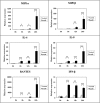
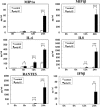

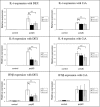
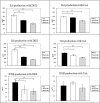

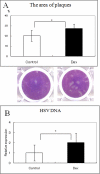

References
-
- Guillot L, Le Goffic R, Bloch S, Escriou N, Akira S, Chignard M, Si-Tahar M. Involvement of Toll-like Receptor 3 in the Immune Response of Lung Epithelial Cells to Double-stranded RNA and Influenza A Virus. J Biol Chem. 2005;280:5571–80. - PubMed
-
- Muir A, Soong G, Sokol S, Reddy B, Gomez MI, Van Heeckeren A, Prince A. Toll-like receptors in normal and cystic fibrosis airway epithelial cells. Am J Respir Cell Mol Biol. 2004;30:777–83. - PubMed
-
- Baker BS, Ovigne JM, Powles AV, Corcoran S, Fry L. Normal keratinocytes express Toll-like receptors (TLRs) 1, 2 and 5: modulation of TLR expression in chronic plaque psoriasis. Br J Dermatol. 2003;148:670–9. - PubMed
-
- Pivarcsi A, Bodai L, Rethi B, Kenderessy-Szabo A, Koreck A, Szell M, Beer Z, Bata-Csorgoo Z, Magocsi M, Rajnavolgyi E, Dobozy A, Kemeny L. Expression and function of Toll-like receptors 2 and 4 in human keratinocytes. Int Immunol. 2003;15:721–30. - PubMed
Publication types
MeSH terms
Substances
LinkOut - more resources
Full Text Sources
Medical
Research Materials
